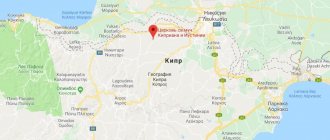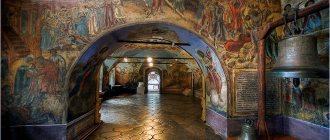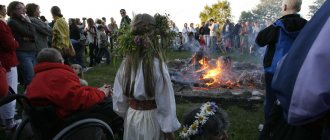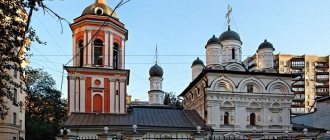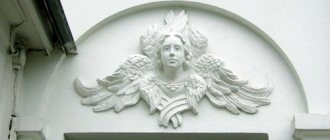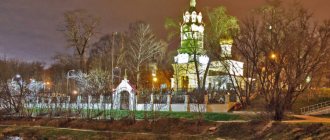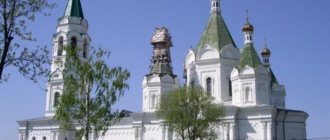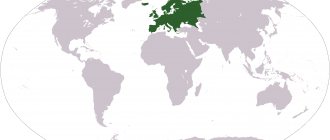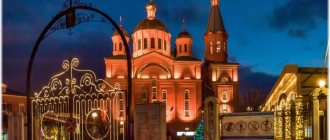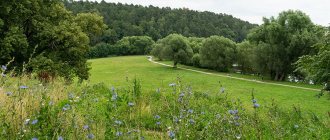Mir
Russia Yaroslavl region village of Godenovo Temple in the name of St. John Chrysostom (Godenovo) Map is loading…
{"format":"leaflet","minzoom":false,"maxzoom":false,"limit":50,"offset":0,"link":"all","sort":[""], "order":[],"headers":"show","mainlabel":"","intro":"","outro":"","searchlabel":"\u2026 \u0441\u043b\u0435\ u0434\u0443\u044e\u0449\u0438\u0435 \u0440\u0435\u0437\u0443\u043b\u044c\u0442\u0430\u0442\u044b","default":"","import-annotation":false,"width ":"auto","height":"350px","centre":{"text":"","title":"""link":"","lat":56.97599799999999703459252486936748027801513671875,"lon": 39.45648899999999770216163597069680690765380859375,"icon":""},"title":"","label":"","icon":"","lines":[],"polygons":[],"circles":[ ],"rectangles":[],"copycoords":false,"static":false,"zoom":8,"defzoom":14,"layers":["OpenStreetMap"],"image layers":[] ,"overlays":[],"resizable":false,"fullscreen":true,"scrollwheelzoom":true,"cluster":false,"clustermaxzoom":9,"clusterzoomonclick":true,"clustermaxradius":80, "clusterspiderfy":true,"geojson":"","clicktarget":"","showtitle":true,"hidenamespace":false,"template":"","userparam":"","activeicon": "","pagelabel":false,"ajaxcoordproperty":"","ajaxquery":"","locations":[{"text":"\u003Cb\u003E\u003Ca href=\"/palomnik/%D0% A5%D1%80%D0%B0%D0%BC_%D0%B2%D0%BE_%D0%B8%D0%BC%D1%8F_%D1%81%D0%B2%D1%8F%D1%82% D0%B8%D1%82%D0%B5%D0%BB%D1%8F_%D0%98%D0%BE%D0%B0%D0%BD%D0%BD%D0%B0_%D0%97%D0% BB%D0%B0%D1%82%D0%BE%D1%83%D1%81%D1%82%D0%B0_(%D0%93%D0%BE%D0%B4%D0%B5%D0%BD %D0%BE%D0%B2%D0%BE)\» title=\»\u0425\u0440\u0430\u043c \u0432\u043e \u0438\u043c\u044f \u0441\u0432\u044f\u0442\u0438\u0442\ u0435\u043b\u044f \u0418\u043e\u0430\u043d\u043d\u0430 \u0417\u043b\u0430\u0442\u043e\u0443\u0441\u0442\u0430 (\u0413\u043e\u 0434\u0435\u043d\u043e\u0432 \u043e)\»\u003E\u0425\u0440\u0430\u043c \u0432\u043e \u0438\u043c\u044f \u0441\u0432\u044f\u0442\u0438\u0442\u0435\u043b\u0 44f\u0418\u043e\u0430\ u043d\u043d\u0430 \u0417\u043b\u0430\u0442\u043e\u0443\u0441\u0442\u0430 (\u0413\u043e\u0434\u0435\u043d\u043e\u0432\u043e)\u 003C/a\u003E\u003C/ b\u003E\u003Chr /\u003E\u003Ca href=\"/palomnik/%D0%A1%D0%B2%D0%BE%D0%B9%D1%81%D1%82%D0%B2%D0%BE: %D0%90%D0%BD%D0%BD%D0%BE%D1%82%D0%B0%D1%86%D0%B8%D1%8F\" title=\"\u0421\u0432\u043e\u0439 \u0441\u0442\u0432\u043e:\u0410\u043d\u043d\u043e\u0442\u0430\u0446\u0438\u044f\u003E\u0410\u043d\u043d\u043e\u0442\u0430 \u0446\u0438\u044f\ u003C/a\u003E: \u0412 »'\u0445\u0440\u0430\u043c\u0435 \u0441\u0432\u044f\u0442\u0438\u0442\u0435\u043b\u044f \u0418\u043e\u 0430\u043d\u043d\u0430 \u0417\u043b\u0430\u0442\u043e\u0443\u0441\u0442\u0430 \u0432 \u0441\u0435\u003Cspan class=\"smw-highlighter\" data-type=\"2\" data-state=\" persistent\" data-title=\"\u0418\u043d\u0444\u043e\u0440\u043c\u0430\u0446\u0438\u044f\" title=\"\u0412 \u0445\u0440\u0430\u043c\u0435 \u0441\ u0432\u044f\u0442\u0438\u0442\u0435\u043b\u044f \u0418\u043e\u0430\u043d\u043d\u0430 \u0417\u043b\u0430\u0442\u043e\u0443\u0 441\u0442\u0430\u0432\u0441\ u0435\u043b\u0435\u0413\u043e\u0434\u0435\u043d\u043e\u0432\u043e\u043d\u0430\u0445\u043e\u0434\u0438\u0442\u0441\u044f\u 0416\u0438\u0432\u043e\u0442\ u0432\u043e\u0440\u044f\u0449\u0438\u0439 \u041a\u0440\u0435\u0441\u0442 \u0413\u043e\u0441\u043f\u043e\u0434\u0435\u043d\u0 44c\u2014\u043e\u0434\u043d\ u0430 \u0438\u0437 \u0432\u0435\u043b\u0438\u0447\u0430\u0439\u0448\u0438\u0445 \u0441\u0432\u044f\u0442\u044b\u043d\u044c \ u043f\u0440\u0430\u0432\u043e\ u0441\u043b\u0430\u0432\u043d\u043e\u0439 \u0420\u043e\u0441\u0441\u0438\u0438. \u0425\u0440\u0430\u043c \u044f\u0432\u043b\u044f\u0435\u0442\u0441\u044f \u043f\u043e\u0434\u0432\u043e\u0440\u044c\u0435\ u043c\u041d\u0438\u043a\u043e \u043b\u044c\u0441\u043a\u043e\u0433\u043e\u043c\u043e\u043d\u0430\u0441\u0442\u044b\u0440\u044f, \u0447\u0442\u043e 2\u041f\u0435\u0440\u0435\ u0441\u043b\u0430\u0432\u043b\u0435-\u0417\u0430\u043b\u0435\u0441\u0441\u043a\u043e\u043c\"\u003E\u003Cspan class=\"smwtext\"\u003E\ u2026\u003C/ span\u003E\u003Cspan class=\»smwttcontent\»\u003E\u0412 »'\u0445\u0440\u0430\u043c\u0435 \u0441\u0432\u044f\u0442\u0438\u0442\u0435\u043b\u0 44f\u0418\u043e \u0430\u043d\u043d\u0430 \u0417\u043b\u0430\u0442\u043e\u0443\u0441\u0442\u0430 \u0432 \u0441\u0435\u043b\u0435 \u0413\u043 e\u0434\u0435\u043d\u043e\u0432 \u043e"' \u043d\u0430\u0445\u043e\u0434\u0438\u0442\u0441\u044f \u0416\u0438\u0432\u043e\u0442\u0432\u043e\u0440\u044f\u044 9\u0438\u0439\u041a\u0440 \u0435\u0441\u0442 \u0413\u043e\u0441\u043f\u043e\u0434\u0435\u043d\u044c \u2014 \u043e\u0434\u043d\u0430 \u0438\u0437 \u04 32\u0435\u043b\u0438\u0447\u0430 \u0439\u0448\u0438\u0445 \u0441\u0432\u044f\u0442\u044b\u043d\u044c \u043f\u0440\u0430\u0432\u043e\u0441\u043b\u0430\u0432\ u043d\u043e\u0439\u0420\u043e \u0441\u0441\u0438\u0438. \u0425\u0440\u0430\u043c \u044f\u0432\u043b\u044f\u0435\u0442\u0441\u044f \u043f\u043e\u0434\u0432\u043e\u0440\u044c\u0435\ u043c [[\u0421\u0432\u044f \u0442\u043e-\u041d\u0438\u043a\u043e\u043b\u044c\u0441\u043a\u0438\u0439 \u0436\u0435\u043d\u0441\u043a\u0438\u0439 \u043c \u043e\u043d\u0430\u0441\ u0442\u044b\u0440\u044c (\u041f\u0435\u0440\u0435\u0441\u043b\u0430\u0432\u043b\u044c-\u0417\u0430\u043b\u0435\u0441\u0441\u0 43a\u0438\u0439)|\ u041d\u0438\u043a\u043e\u043b\u044c\u0441\u043a\u043e\u0433\u043e \u043c\u043e\u043d\u0430\u0441\u0442\u044b\u0440\u044f]],\ u0447\u0442\u043e\u0432 \u041f\u0435\u0440\u0435\u0441\u043b\u0430\u0432\u043b\u0435-\u0417\u0430\u043b\u0435\u0441\u0441\u043a\u043e\u043c\u003C/s pan\u003E\u003C/span\ u003E","title":"\u0425\u0440\u0430\u043c \u0432\u043e \u0438\u043c\u044f \u0441\u0432\u044f\u0442\u0438\u0442\u0435\u043b\u044f \ u0418\u043e\u0430 (\u0413\u043e\u0434\u0435\u043d\u043e\u0432\u043e) ""link":"" ,"lat":56.97599799999999703459252486936748027801513671875,"lon":39.45648899999999770216163597069680690765380859375,"icon":""}],"image Layers":[]}
56.976427; 39.457681
Russia, Yaroslavl region, Rostov district, rural settlement Petrovskoye, village Godenovo
Godenovo village, Yaroslavl region
Russia
Telephone:
(call from 11:00 to 15:00 daily, except Sunday).
Email:
In the Church of St. John Chrysostom in the village of Godenovo
The Life-Giving Cross of the Lord is located - one of the greatest shrines of Orthodox Russia. The temple is a courtyard of the Nikolsky Monastery in Pereslavl-Zalessky, and for many years the sisters have been leading the story of the Life-giving Cross of the Lord, which appeared to shepherds in the Sakhota swamp in 1423.
History[edit]
Not far from the city of Petrovsk there is an amazing place - the small village of Godenovo. Here stands the Church of St. John Chrysostom - a church in which a great shrine has been kept for almost a hundred years - the undiscovered Life-giving Cross of the Lord.
Chrysostom Church was built in 1794, and since then it has never been closed. Neither revolution nor war seemed to touch her. All these years, the ancient paintings of the early 19th century and the iconostasis of the same time were carefully preserved there.
The left side chapel of the church is consecrated in honor of the Bogolyubskaya Icon of the Mother of God. There, in a fireproof icon case, the Life-Giving Cross is put on public display. Pilgrims travel to Godenovo all the time to worship him, and in the St. Nicholas Monastery of Pereslavl-Zalessky they carefully record all the miracles that occur through prayer addressed to the ancient Crucifixion. This cross was secretly transferred at night to the Church of St. John Chrysostom in 1933 from the Church of the Exaltation of the Cross in St. Nicholas Pogost, and since then it has been called the Goden Cross.
Since then, the Cross has been taken care of, but it was, of course, closed to public worship until 1997.
And already at the end of the twentieth century, this temple became the courtyard of the Nikolsky Monastery in Pereslavl-Zalessky.
History of the Church of St. John Chrysostom
In the 17th century, two stone churches were erected in the city, consecrated in honor of John Chrysostom. One church was built in the Kremlin, near the Assumption Cathedral. But, unfortunately, it was demolished in the 30s of the last century, during the struggle of the Soviet government against religion. So today you can see this architectural monument only in old photographs.
View of the church from the Volga
Another Chrysostom temple, a summer church, was built in the former Doilova Sloboda, which later became known as Korovniki. Money allocated by wealthy Yaroslavl residents Fedor and Ivan Nezhdanovsky was used for this. The construction took 5 years, and in 1654 the new church was consecrated.
Later, both ktitors (benefactors) and members of their families were buried in its southern aisle.
Information has been preserved that soon after its construction the temple played a big role in the life of Yaroslavl. After the terrible fire of 1658, the relics of the holy Prince Fyodor Konstantinovich Cherny, the heavenly patron of the city, as well as his sons David and Konstantin, were transferred from the burned Spassky Monastery to the Chrysostom Church. And for some time they were kept in this church.
A little more than a quarter of a century has passed since construction and a new generation of Yaroslavl architects has taken up the task of radically remaking the church. To make the temple better illuminated, high window openings were cut into its main volume and decorated with elegant platbands. At the corners of the building, the builders made elegant clusters of half-columns with colored tile inserts. The roof covering was replaced with a more practical flat hipped roof. And to further emphasize the graceful lines of the temple, decorative porches were added to it, also decorated with ornaments of colored tiles and white stone carved weights on the entrance arches.
During this reconstruction, the squat galleries were bricked up. Here Yaroslavl craftsmen showed great imagination and diligence. They decorated the blocked openings with lush brick platbands, the patterns of which are not repeated anywhere, and they decorated the church facades with a multi-color palette of tiled inserts. The quality and beauty of the figured masonry speaks of the high skill of the masons working at that time. This alteration gave the church an elegant and festive look, making it one of the most beautiful churches not only in the city, but also in Russia.
Platband on the altar
For a long time, parishioners could not raise the necessary funds to decorate the church from the inside. Therefore, painting of the walls began only in 1732-1733 by the famous Yaroslavl bannerman, that is, a highly qualified master, Alexei Soplyakov, together with an artel of local icon painters.
Although this painting was done at a time when the Baroque style was in its heyday in Russia, the Yaroslavl residents completed more than 500 subject marks in the old icon-painting traditions.
In the paintings created by Soplyakov, art critics note a special illuminated light range, with almost watercolor halftones, as well as an impeccable composition. It is known that in 1863 the temple painting was renewed using glue technology. And in the 60s of the last century, the wall paintings were restored by a team of Yaroslavl masters, under the leadership of V.I. Vasina.
At the end of the 19th – beginning of the 20th century, a parochial school, a guardianship and a library with a reading room were opened at the church. Rare works by the famous Russian photographer Sergei Mikhailovich Prokudin-Gorsky, made by him in 1911, brought to us the appearance of the Church of St. John Chrysostom at the beginning of the 20th century. In color photographs, the temple appears with whitewashed walls, on which red-brick decorative elements and colored tiles stand out in contrast. A real fairy tale in stone!
The church was closed in 1935, and its premises began to be used for warehouses.
Unfortunately, after several years of storing salt inside the temple, some of the frescoes on its walls were irretrievably lost. In 1992, the church was transferred to the jurisdiction of the Russian Old Believer Church, which began its restoration.
View of the church from the north-west
Description[edit]
From an architectural point of view, the temple in the name of St. John Chrysostom is a widespread architectural structure, considered the “calling card” of Russian religious architecture in that era when new-fangled architectural trends, which had taken root in big cities, confidently stepped into the provinces, and the provinces still equally confidently insisted on preserving traditional architectural forms. The cube, the hipped roof, the five-domed building, the hipped bell tower - everything at first glance looks like it was in the pre-Petrine era. Although the experienced eye, of course, can see that this is the most provincial 18th century. The five-domed structure is deliberately shredded relative to the total volume of the quadrangle, and is also visually reduced by narrow drums and specific, in the spirit of Russian Baroque, domes on “necks”. This is a new aesthetic - the era of the mighty Yaroslavl domes, which sometimes accounted for up to half the height of the entire temple, was becoming a thing of the past... And the bell tower’s tent is no longer the same as it was made in the 17th century. The kokoshniks alone, separated by a straight cornice, are worth something - comparable to the traditional arched end of a bell pillar, characteristic of pre-Petrine architecture. The old tents were not only an aesthetic, but also a constructive, functional continuation of the pillar. In the 18th century they had more of a decorative function. This trend will reach its apogee by the second half of the 19th century - when, during the heyday of the “pseudo-Russian” style, there will be a new surge of interest in hipped bell towers. That’s how it is, but only when compared, most of the “retrospective bell towers” of the 19th century will certainly lose in elegance to the “original bell towers” of the seventeenth century. The base of the bell tower rests on the vault of the refectory. The phenomenon is not very common in Russian architecture, but was nevertheless practiced by Rostov architects of the 18th century. Everything above the vaults is more traditional. The small quadrangle of the base turns into an octagonal pillar.
An interesting detail that is not immediately noticeable is that the arched openings of the bell tier are not equal in width: those facing strictly to the cardinal points are much wider. The altar part of the temple is a developed semicircular apse, decorated with decor that strictly repeats the decoration of the main volume, and covered with a high, as if “swollen” conch. This somewhat hypertrophied volume visibly pulls the center of gravity of the temple towards the altar part - this is especially noticeable from the northern facade. The quadrangle of the temple is almost strictly cubic in volume, the corners are accentuated by decorative blades. A perspective portal, fairly simple platbands and a cornice with “triangles” are recognizable elements of Russian architecture of the pre-Petrine era. However, there are no kokoshniks, much less zakomars - eight in a row of promising semi-circular niches between two cornices seem to hint at a belt of kokoshniks, but upon closer examination it turns out to be a prop. The gate with the fence appeared much later than the temple itself, but fit well into the overall ensemble. Their airy grace became a good architectural antithesis to the massive Bogolyubsky chapel, which somewhat “flattened” the temple across the square, “pressing” it to the ground. Being as close as possible to the western façade, the gates seem to fit into it, actively entering into the overall play of architectural volumes and verticals.
The interior of the Chrysostom Church logically breaks down into two independent volumes: the “main temple” itself and the chapel in the name of the Bogolyubskaya Icon of the Mother of God. This goes without saying. But there is also something outside the usual logic: it just so happens that the “main temple” these days is actually a secondary volume, the main attention is focused on the aisle... It’s not surprising - after all, it is in the aisle that the main Shrine is located - the Life-Giving Cross! On the other hand, the main temple is interesting for its frescoes and icons. Summer temple. Its interior volume is double-height, the walls are painted a calming soft lilac color. A large area is occupied by frescoes, made, however, not in continuous murals, but as if in the form of paintings enclosed in frames. This is a well-recognized style and technique of the 19th century: the temple, which never closed, was lucky enough to preserve the original paintings. They cover the vaults of the temple, and in the niches of the windows there are life-size images of saints. The modern fresco, gilded carved four-tiered iconostasis, made with great skill, is very good. Particularly impressive are the details of the floral ornament and the skillfully decorated royal doors, on both sides of which there are images of the Savior and the Mother of God in precious frames. The iconostasis is topped with a crucifix. In the arched passage from the refectory to the temple itself, on the wall to the right, there is a temple icon of St. John Chrysostom.
The Bogolyubsky chapel, adjacent to the main building from the north, is designed more laconically: in the center is the Life-giving Cross of the Lord, which is located to the right of the iconostasis. The altar barrier is single-tiered. There are no frescoes - the walls are covered with whitewash. Venerated ancient icons hang on the walls, among them the Bogolyubsky image of the Mother of God, John the Baptist and St. George with his life and other icons.
Shrines[edit]
- Life-giving Cross of the Lord
Godenovo Cross
The life-giving Cross of the Lord - one of the greatest shrines of Orthodox Russia - found its abode in the Temple in the name of St. John Chrysostom in the village of Godenovo, not far from the city of Pereslavl-Zalessky. The temple is part of the courtyard of the Nikolsky Monastery, and for many years the sisters have been leading the story of the Life-giving Cross of the Lord, which appeared to shepherds in the Sakhota swamp in 1423.
The life-giving Cross of the Lord was miraculously revealed to the shepherds of a nearby village in a swamp, 55 versts from the city of Rostov. Having seen the Life-giving Cross of the Lord above the impassable swamp in the middle of an indescribable pillar of light in the air, the shepherds, with the blessing of the bishop, began to build a church a mile away from this place. However, the foundation of the church they made by God’s will moved to the place of the miraculous phenomenon, over which the Life-giving Cross again shone. And they heard a voice from him: “In this place you will build my church.” That same night, after a strong storm, part of the swamp turned into a dry hill, where the church was built. After this, the revealed image of Christ’s crucifixion became visible and accessible to everyone. The past centuries preserve the history of many miracles and grace-filled healings from these shrines.
- The miraculous icon of St. Nicholas
Location of the structure
Few people know where the cathedral is and how to get to it.
The temple is located in the center of old Yalta on the elevation of Polikurovsky Hill.
Polikurovsky Hill is of great importance for the city, since it is believed that Yalta was born here and begins from here. Translated from Greek, Polikurovsky Hill means “old place”, “old village”. The “starting point” can be seen from any city street. This hill continues in the form of a stone cape called “Church”, which slightly extends into the sea.
P.I. Sumarokov in his work “Traveling through the Crimea” claims that in 1799 Yalta consisted of thirty houses that were founded by fishermen and were located around Polikurovsky Hill. He also says that there was a small military town and an old church here. Over time, the boundaries of the village expanded, and in 1837 it was recognized as a city.
A quarantine hospital, a port, a customs post, as well as the current temple were built on Polikurovsky Hill.
How to get there
To get to the temple by transport, you need to know that the nearest bus stop is “Clothing Market” in Yubileiny Square.
To travel on foot, consider the direction to the cathedral from the city embankment, since every tourist knows about its location. At the beginning of the embankment there is a monument to Lenin. From the Lenin monument, you need to turn onto Roosevelt Street towards the east and walk along it until it intersects with Sverdlov Street. The marine terminal, which is located nearby, can serve as a reference point. From the marine terminal you need to turn left and walk a little. On the way you will meet the Chapel of St. Nicholas. It is located near Massandra beach. The chapel was built in 1896 according to the design of the architect N.P. Krasnov in honor of the wedding of Nicholas II and Alexandra Fedorovna. On the site of this small landmark, Yalta received city status. A memorial plaque commemorates this significant event.
From this chapel you need to walk along Sverdlov Street, and then go up a little along Tolstoy Street and turn right. You can get out onto the street itself by going around the “Yard at the Pier” restaurant. After walking a little, you will see the building of the majestic cathedral and enter the temple territory.
How to get there[edit]
Address:
Yaroslavl region, Rostov district, Godenovo village.
Directions:
Distance from Moscow to Godenovo: from Moscow to the city of Petrovsk 180 km, from Petrovsk to Godenovo - 15 km, total - 195 km.
How to get to the Church of St. John Chrysostom in Godenovo on your own:
by train or by bus to Petrovsk, then by local bus to the village. Priozerny to the village of Godenovo. Bus departure times are 7.00, 11.40, 15.10 (information as of July 2010).
How to get to the Church of St. John Chrysostom in Godenovo by car:
if you are coming from Moscow, then in the city of Petrovsk (located between Pereslavl-Zalessky and Rostov the Great) turn right following the sign to the Temple of St. John Chrysostom. Then follow the signs for Godenovo to the Church of St. John Chrysostom - it’s impossible to get lost. In the village Demyanskoe at the T-shaped intersection turn left onto Priozerny. After the village of Priozerny, turn left onto Godenovo - also following the sign. If you drive straight at this place, the road will lead to Antushkovo - first there will be Zakharovo, and then the road (an embankment dam) will lead directly to the Monastery of the Descent of the Cross at the Nikolsky Pogost. From Petrovsk to the turn to Godenovo and to Godenovo itself there is a good asphalt road, and from the turn to Godenovo to Zakharovo the same. From Zakharovo to Antushkovo - to the place of the appearance of the Cross and the holy spring, where now the Monastery of the Descent of the Cross is a dirt road, and it is difficult to drive in bad weather.
Telephone:
(call from 11:00 to 15:00 daily, except Sunday).
Fax machine:
8(48535) 3-06-45
Email:
Website:
https://www.godenovo.ru/
